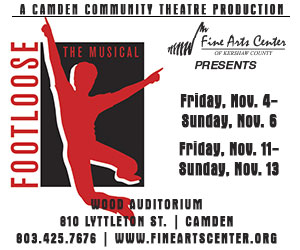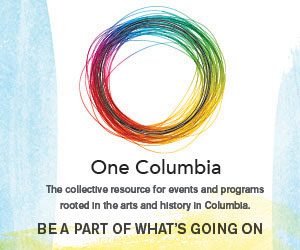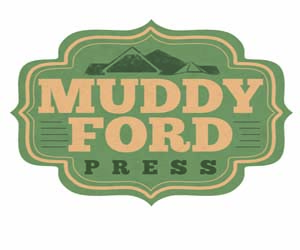ESSAY by Ed Madden — Tonight, it’s a birthday party, or transformation, beauty, and community at GUESSWORK
The big garage doors are open, the weather perfect. It used to be a radiator shop, I think, its bays marked by the row of rolled-up doors. Now it’s an artist’s studio, painted red. Tonight, it’s a birthday party. There’s a grill pulled out, smoke seeping from under the lid. There’s an old green sofa pulled out onto the gravel near the grill. Small chairs orient themselves around the sofa. A bar against a far wall. Tables for food. Music fills the space and spills out into the May air.
Above us, in the lot next door, a cell tower occasionally flashes its red lights. This corner is a transit point, gathering conversations, stories—laughter, desire, debt, decision—ideas ricocheting out across the city. Someone is turning 35, someone else 42. Billy’s not here, but in so many ways he is. Someone looks up, laughs, “Reception must be really good here.”
People arrive slowly, some bringing chairs to add to the circle near the grill. Grayson drags a rolling desk chair out of the building and onto the gravel. Coralee sits on the green sofa, greeting everyone; she knows everyone. There are gifts – bottles of port, a painting of Grayson’s dog by a friend. The party begins to orbit slowly around the green sofa, the grill, and as the evening darkens, around a table inside on which is spread a blank canvas, beside it a box of paint tubes and brushes, some spray cans, a box of markers.
A few people start with stencils—ART stenciled three times on the canvas. Someone adds to one, “But is it.” Is it art? Rob, a painter, adds a swirl of green and white and shadow in the lower right corner. There’s a smiley face stencil, one version doubled like the shift of lenses in the optometrist’s office, another transformed into a monkey.
Conversations move and flow like music, like a cocktail with its muddle of flavors. Chandra talks about his green card, his impending application for citizenship. He is wearing a scarf around his neck, striped brick red and grey and black. Karl has WANT. tattooed on his arm. I am struck by the period at the end, as if this were a sentence, an imperative. Bohumila has a beautiful temporary tattoo of white and gold leaves on her shoulder. I try a grapefruit ginger beer. Three strong competing flavors. Bad idea. I try Bohumila’s cranberry ginger ale mojito, the strong finish of mint that hits my sinuses when I swallow and breathe. Sweet, subtle. A good idea.
Another local artist goes to the canvas, takes the top left corner, paints a gesture of a tree—a few strokes of green, drops of green and orange. It’s lovely. I don’t know her name. I realize I don’t know many people here. Many I recognize by sight from arts events. I feel like I should introduce myself—but I’m sometimes, despite what some might think, a little introverted, prefer to slide to the side of the party and talk with one or two people I know. Maybe that’s okay at a party like this one, in a community like this. Someone draws a pink flower on the canvas, its multiplying petals like a carnation or rose on steroids. I imagine it as gif, as video, the endless opening of the thing. Someone else squeezes a tube of white, dribbles small blobs directly onto the canvas. Someone says it looks like bird droppings.
John the pilot is telling Bert about a film he saw at festival—something about Scottish men making ballet slippers. He talks about the contrast in the film, the juxtaposition of stories—the movement of the ballet dancers, their small feet, the big burly man, his large hands forming the satin shoes, the mastery of it.
~
Grayson shows us around the place. The large white EMERGENCY sign lighting up a back corner, salvaged from some hospital. He says they need to sage the shit out of it, get rid of its bad juju. Beneath it, a drafting table with a list of things the artist needs.
There are potted plants out front—moonflower, candelabra bush, sedum. There’s sign on the front of the building, the lettering made of small metal objects. It’s one of the things Billy does, makes art of found things. Grayson takes us around the corner, gestures to a meadow marked by a mown path circling through the grass. It was a field of red clover, he says, but it’s no longer red, the clover gone to seed. We take in the absence of the color, the twilight swirl of green and white and shadow.
Barry calls everyone to eat, laying out the burgers, the maple-smoked bacon. He waves his hands as he gestures toward the food, almost a magician’s flourish. I can’t help but think of an another party we went to, the thin blackened burgers, the bland pasta salad. I put onions and mushrooms on my burger. I follow Bert’s example, smear a dollop of green guacamole on the bun.
~
Inside, we’re drawn to the far wall, a row of metal cabinets, on top of them a series of pieces made of branches and tin cans. Ashley walks over with us. To the side there is a display of hanging pieces—dimpled metal in various shades, framed. Ashley says they’re old ceiling tiles from some historic building downtown. They were dumped; Billy salvaged them. Dimpled and distressed, the institutional white paint flaking off, an institutional grey revealed beneath. Arranged and framed like abstract expressionist paintings, collages. On some, he stippled a drops of vivid red, stipples glistening like little puddles, like blood.
We talk about the building, about the artist’s careful organization of tools and materials, about scavenging as aesthetic practice. I think about the little bag of odd plastic bits I keep for another artist, their interesting shapes and colors, the fact that their shape or size or type makes them ineligible for city recycling—they would end up in the trash. In one drawer Ashley slides out, there are plastic gelato containers with lids to organize small things. “We do that, too.”
Ashley tells us about a photography studio she used to own. Women could get beauty sessions or pin-up sessions—glamorous shots or shots in the style of old 1940s pinups, the big soda can curls. Some people wouldn’t think so, she said, but it was a feminist project. It was empowering, she said, you should read some of the testimonials. She hired someone to do makeup and hair. There were no mirrors in the hair and makeup area, only in the dressing room, where, the first time the women say themselves, they saw the complete look in a full-length mirror. The mirror was tilted just enough, she said, to remove a few pounds. The makeup artist stayed through the session in case she needed to zhuzh the hair, or reapply the eyes after the women saw themselves in the mirror for the first time. Many cried.
As we talk, the lights go down in the room, only some side lights, the EMERGENCY sign, a disco ball now spinning in the ceiling. Across the room we can see a large piece made of bright red Lego bricks, like a 6-foot wall hanging above the office door. The piece is brilliant red, but the overhead light makes it textured, marked by divets and fissures of shadow.
Ashely says she wanted the women to feel special, feel glamorous. There was a big purple sofa, there were white and gold tables. They were given prosecco to sip as they got ready for the photo shoot. She limited them to two glasses.
“I could edit out everything but drunk,” she smiled.
~
Eileen squeezes orange onto the painting, then wipes the bright orange and those blobs of bird dropping white with her hand—a stunning brush of bright movement at the center of the canvas. Barry laughs, “Yes!” She lifts her orange hands and smiles. The music is louder, I think, or maybe it’s just the drink and the darkness, the scattered conversations. Near the bar, a guy is teaching a clapping game to someone. They clap to the music and she laughs. There’s a sense of collaboration to a party like this, a sense of community.
More people move to the canvas. Lucas wears a blue shirt and a gray hat. Shannon wears a bright red and white floral print. Several people wear jeans and t-shirts, warned in advance of the possibility of stray paint. There are green Solo cups of water and paint brushes now on the table, the canvas filling with layers of paint and image, splatter and movement and strange drawings. Eileen slaps a copy of Jasper onto the canvas. When I pull it away, the green and orange intimation of tree is half flattened, the other half still glistening in raised gestures of paint, stronger and brighter now by contrast. Someone adds a black and red scribble of volcanic hill to the base.
John the pilot and his wife Sharon talk to Bert about antiques. One of them, I forget which, describes sheds stuffed with possessions, a grandparent who kept everything. Bert talks to them about the variables of value. They have old medical books—are these worth anything? Bert laughs, looks at me, says, “Some people collect that kind of thing.” Bert has auctions ending on ebay this weekend—old yearbooks, a book of George Rodrigue’s blue dog paintings, a Hermès scarf.
Linda tells us to have a happy Mother’s Day. I think about my mother. I think about how I stood in front of all the manufactured cards in the grocery store—all those bland and simple fictions of sentiment—reading them all and finding nothing that seemed factual or right or true to the complexity of the thing. Nothing I could send home that wouldn’t be wishful thinking. I think about a trip home in a week for a nephew’s graduation. I’ll be alone with my family. We’ll go to church.
I can breathe here.
John the photographer (not the pilot) shows me a video he just shot on his phone—a short film of the disco ball mounted above the wooden beams, the way it constellates the ceiling. I try out my phone on something more pedestrian—film the lights circling the concrete floor, moving among people’s feet. I play it back: oddly delighted by the moving lights, people standing, talking. It captures the music, Chic’s “Good Times” as soundtrack to feet and dancing lights. The phone gets the ambient chatter too, someone saying, “Linda and Corinne and I—” The video stops just as the story begins.
These are the good times. Our new state of mind.
Linda and Corinne and someone else could be about to do anything.
~
A rumor has it that it’s getting late. Time marches on, just can’t wait. . . . Good times. These are the good times.
Bert says it’s about time for the Irish goodbye. We have a morning of gardening ahead, some new plants to get in the ground after an earlier trip to the garden center. New roses, peppers, tickseed, things for the sun. And a small native iris, a low unassuming bloom for deep shade, hidden beauty.
We also have his sister’s Mother’s Day cookout. I don’t think we have a card for her. We’ll take a vase of flowers from the yard. Bert’s niece says she is not giving cards to people anymore. She says they only look at them for a second and then throw them aside. They cost too much. She says she’ll spend that much more money on a gift. Bert says we should make her a card for her birthday this summer. No store-bought cards, handmade instead—a different option.
Tomorrow morning, we will see pictures from the party on Facebook, a post of the final collaborative canvas, an emblem of that community of artists and friends. There will be Karl’s red stuttering EKG line on one border, another version of it submerged but partially visible in a diagonal across the canvas, like life’s rhythm just below the surface, layers, scratches and crosshatching in the paint. On one border a carefully lettered FINE ART. Someone will comment online, “I am still washing off the paint.”
Someone will say, “I want what they were drinking.” Someone will suggest printing the image on t-shirts. Someone will add, “This would make fabulous scarves.”
Someone will say, “I want this printed on a comforter.”







.jpg)
